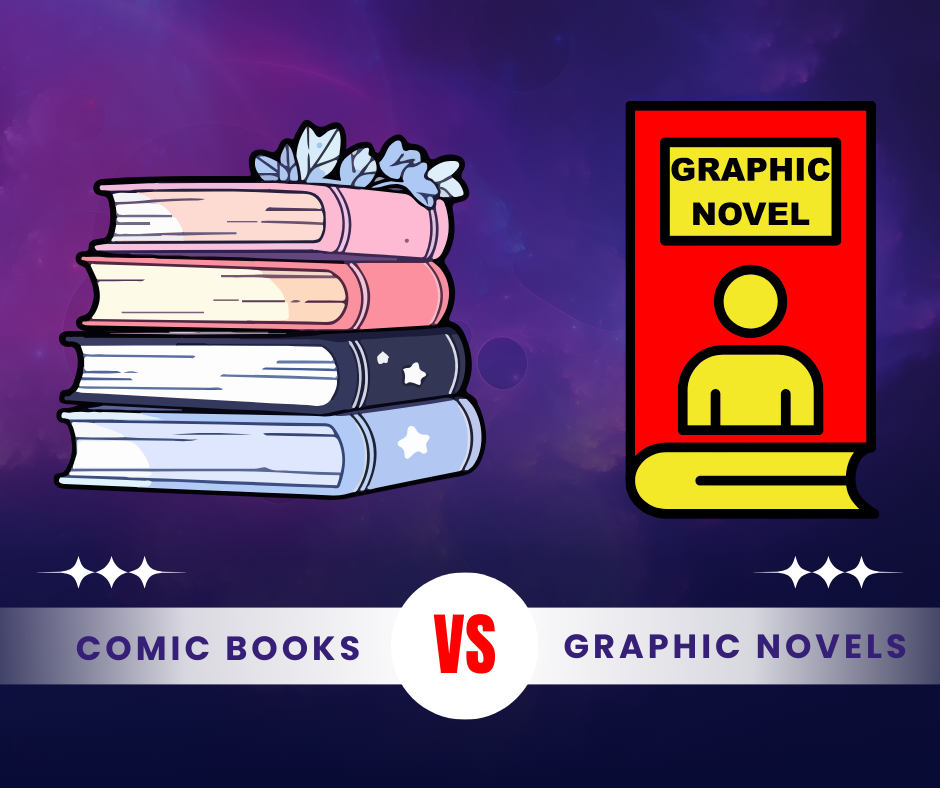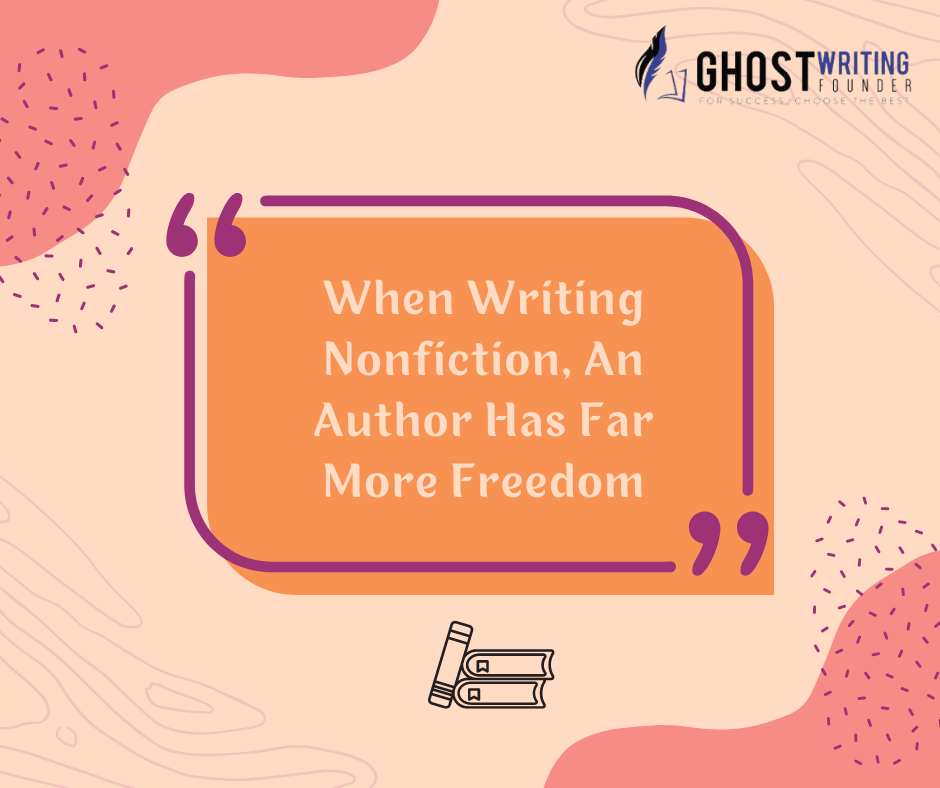
Book
Comic books vs. graphic novels are both captivating forms of storytelling that combine visual art with text to bring stories to life. However, despite their similarities, they have distinct differences catering to diverse audiences and preferences.
The key differences between comic books and graphic novels help you understand what differentiates these two genres.
Defining Comic Books and Graphic Novels:
Firstly, let’s break down Comic Books vs. Graphic Novels.
Comic Books: Picture a thin magazine with pictures and speech boxes all over it. It’s a picture book! Comic books are generally short. They often have superheroes in them, like Batman or Spider-Man, but they can also tell stories, like puzzles or comedies.
Graphic Novels: Now, picture a thicker book, almost like a novel, but with many pictures. That’s a graphic novel. Graphic novels are longer and tell a complete story in one book. They can be about anything, from fantasy worlds to real-life adventures. While some graphic novels feature superheroes, many explore different genres and themes, appealing to a wide range of readers.
Origins of Comic Books:
Comic books have a fascinating history dating back to the early 20th century. They first emerged as a popular form of entertainment in the United States during the Great Depression. At that time, people were looking for affordable ways to escape the harsh realities of life, and comic books provided just that.
Modern comic books started as newspaper comic strips, which told stories in a series with funny characters and plots. Therefore, people all over the country liked these daily strips, making them very well-known.
As the demand for more comic content grew, publishers began comic book making and printing collections of these strips in magazine format, giving birth to what we now know as comic books. The earliest comic books featured reprints of popular newspaper strips. Still, original stories and characters soon emerged, paving the way for the vibrant and diverse world of comic books we know today.
Characteristics of Comic Books:
Comic books are characterized by their unique blend of visual storytelling and written narrative. Unlike traditional novels or short stories, comic books use a combination of illustrations, dialogue, and captions to convey their tales. This visual aspect sets comic books apart, making them a dynamic and engaging medium.
One of the defining features of comic books is the use of panels, which are individual frames that contain a specific moment or scene in the story. These panels are arranged sequentially on each page, guiding the reader through the narrative in a visually cohesive manner.
Another critical characteristic of comic books is their serialized nature. Many comic book series are released regularly, with new issues occurring monthly or weekly. This episodic format allows for ongoing storylines, character development, and cliffhangers, keeping readers eagerly anticipating the next instalment.
Characteristics of Graphic Novels:
Graphic novels share many similarities with comic books, including using illustrations to convey stories. However, Ghostwriting Founder shares several distinct characteristics that set graphic novels apart and define them as a unique medium.
First and foremost, graphic novels are often complete, self-contained narratives published in a single volume. Graphic novels, on the other hand, tell a story from start to finish in the pages of a single book, while comic books are usually ongoing and come out at regular intervals. Reading list organization makes reading more enjoyable because readers can get into the story without interruption.
Format and Structure Differences in Comic Books Vs Graphic Novels:
Comic Books:
- Published in a series and released in different issues at regular intervals.
- Each issue contains a self-contained story or part of a larger narrative arc.
- Compact format with pages typically measuring around 6.625 x 10.25 inches.
- Pages are divided into panels, arranged sequentially to guide the reader through the narrative.
- Features colourful artwork, dynamic action sequences, and speech bubbles containing dialogue and narration.
Graphic Novels:
- Standalone works that tell a complete story within a single volume.
- Published in book form with dimensions similar to traditional novels (e.g., 6 x 9 inches or 8.5 x 11 inches).
- A more expansive format allows for longer and more complex narratives.
- Chapters or sections flow seamlessly into one another, creating a cohesive reading experience.
- Utilizes panels and artwork but may employ more sophisticated visual storytelling techniques.
- May incorporate text elements beyond dialogue, such as captions, narration boxes, and descriptive passages.
Importance of Recognizing and Appreciating Both Mediums:
1- Diversity of Stories: Readers can get a wide range of stories by understanding and enjoying comic books and graphic novels. Comic books usually have ongoing adventures and character stories. In Comic Books vs. Graphic Novels, graphic ones have bigger, more complex stories that cover a wider range of topics and genres.
2- Broadening Perspective: Accepting both media types pushes readers to broaden their views and try new ways of telling stories. Both comic books and graphic novels have their strengths and appeal to different types of readers, making reading more enjoyable overall.
3- Supporting Creativity: Readers can help artists who work in comic books and graphic novels by recognizing and appreciating both. This helps keep a rich and varied environment of stories alive, which encourages creativity and new ideas in the comic book and graphic novel industries.
Future Outlook for Comic Books and Graphic Novels:
Comic books and graphic novels appear to have a bright future, as they both seem set to flourish and change over the coming years. Through acknowledgement and appreciation of the distinct contributions made by comic books and graphic novels, readers can continue to enjoy various telling experiences.
1- Continued Growth:
The future outlook for Comic Books vs. Graphic Novels is promising, with continued growth expected in both mediums. As digital distribution channels and online platforms become more prevalent, comic books and graphic novels will likely reach new audiences and expand their global reach.
2- Diversification of Content:
Comic books and graphic novels may add new storylines, styles, and themes. Plus, there will be more stories in both, so readers with all tastes and hobbies can find something they like.
3- Innovation in Storytelling:
The future of comic books and graphic novels will also see ongoing innovation in storytelling techniques and formats. Comic book creation will continue to push the boundaries of visual storytelling, experimenting with new artistic styles, narrative structures, and interactive elements.
4- Cultural Impact:
Comic books and graphic novels will continue to have a significant cultural impact, influencing other forms of media such as film, television, and literature. As these mediums intersect and cross-pollinate, the influence of comic books and graphic novels on popular culture will only grow stronger.
Conclusion:
As long as Comic Books vs. Graphic Novels keep changing and growing, they will surely have a big impact on the future of stories and our culture. You can find a lot of fun in the changing worlds of sequential art, whether you like the bright adventures in comic books or the deep stories in graphic novels.









Leave a Reply